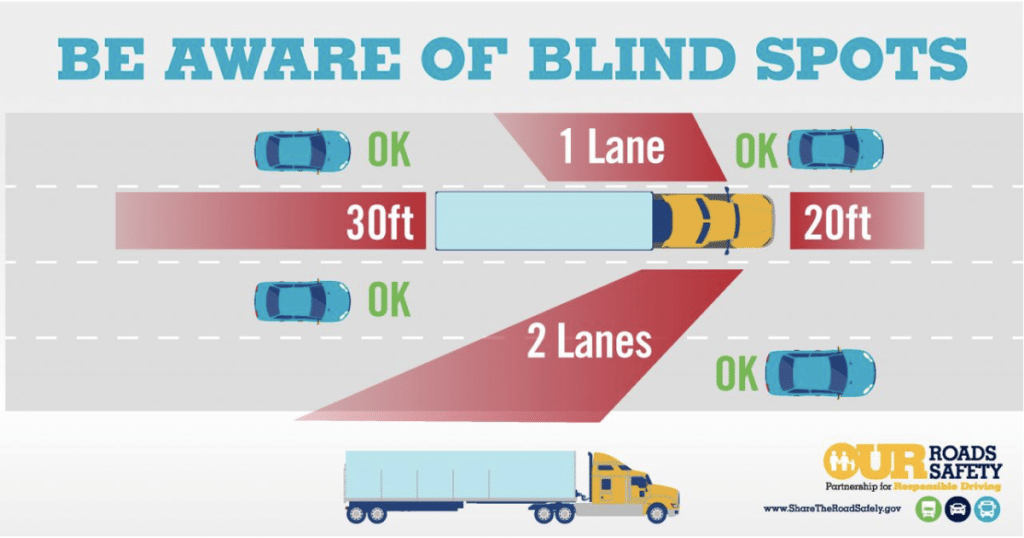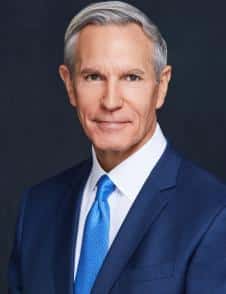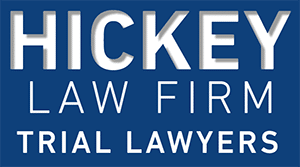Blind Spot Accidents Involving Commercial Trucks
Every vehicle has blind spots. A blind spot is the area on the outside of a vehicle where the driver of that vehicle cannot see.
Large commercial vehicles, including semi-truck trailers, have larger and more blind spots, generally, than cars. There are generally 4 zones of blind spots, called no zones by commercial trucking companies. These zones are on the left side, right side, front, and back. The right side and rear or back or behind the vehicle generally have the largest blind spots.
The right and left sides of large commercial trucks are visible with side view mirrors. Trucks can have cameras or vehicle sensors. The rear of the truck can have cameras or sensors but oftentimes do not.
Bobtails or the semi- tractor can haul different sized trailers, multiple trailers, shipping containers, flatbeds, or lowboys. If the truck is equipped with a bed for hauling it can have bulk or contained cargo on its bed. The longer and wider the trailer, the larger and more the blind spots.
Blind spot accidents involving commercial trucks are frequent. These accidents or crashes happen when the semi-truck driver makes a lane or speed change when he or she is distracted and does not keep track of vehicles coming into the blind spots or does not look in the side view mirrors or the cameras if there are any. A more complete list of these accidents according to the maneuver of the truck is:
- Making a right turn
- Making a left turn
- Changing lanes to the left or to the right
- Moving or turning into intersections
- Moving or turning across cross walks
- Moving forward (where the front blind spot is not observed)
- Backing up
- Sudden speed change
- Stopping in the road
- DUI (under the influence of alcohol, narcotic pain killers, amphetamines to prevent sleep, or any illicit drug
- Unfamiliarity with the road (and thus distracted by the GPS or cell phone)
- Distracted driving (distracted by the smart phone, texting, calling, emailing, or by other electronics onboard including screens for cameras or collision avoidance technology)
These crashes between the semi truck trailer and a car, truck, motorcycle, or pedestrian can be a side swipe, T bone or broadside, an undercarriage accident where the car or motorcycle is caught under the trailer itself, hit by the side view mirrors, or run over by the wheels of the truck or trailer.
Where are a truck’s blind spots?
Blind spots exist for every motor vehicle. However, the blind spots on commercial trucks are larger and present more of a risk for other motorists. A truck’s blind spots are approximately 20 feet directly in front of the truck’s cab, 30 feet behind the truck’s trailer, and diagonally alongside each side of the truck.

(Federal Motor Carrier Safety Administration)
The size and weight of a commercial truck works against drivers for a couple of reasons. Unlike the driver of a smaller car, truck drivers are unable to simply check their blind spots through their mirrors. If a smaller car’s presence is not immediately noticeable in the truck’s mirror, chances are the truck driver cannot see them.
Why the blind spots of commercial trucks are called “no-zones”
That is why a truck’s blind spots are one of the most dangerous areas that other drivers can find themselves in. In fact, the trucking industry refers to a truck’s blind spots as “no-zones” because drivers do not want to stay in those areas for too long.
Still, trucking companies will use the knowledge of “no-zones” to avoid liability for blind spot accidents. Trucking companies and their legal representation will argue that drivers know the dangers of being in a truck’s blind spot for too long.
Statistics tell the story about truck accidents
The statistics of the National Highway Safety Administration (NHTSA) tell the story. In 2020, “a large truck as defined in this fact sheet is any medium or heavy truck, excluding buses and motor homes, with a gross vehicle weight rating (GVWR) greater than 10,000 pounds. These large trucks include both commercial and non-commercial vehicles.” Here is what NHTSA tells us about truck accidents in 2020:
- 4,965 people killed in crashes involving large trucks, down 1% from 5,032 in 2019.
- Per the NHTSA: “From 2019 to 2020 there was a 7-percent decrease in the number of large-truck occupants killed, and a 2-percent decrease in the number of occupants of other vehicles killed in crashes involving large trucks. This is the first decrease in large-truck occupants killed, and occupants of other vehicles killed since 2013 to 2014. From 2019 to 2020 there was a 9-percent increase in the number of nonoccupants killed. The 622 nonoccupants killed in large-truck crashes in 2020 was the greatest number killed in the most recent 10-year period.”
- 71% of the people killed were occupants of other vehicles.
- 76% of these fatal crashes occurred between 6 a.m. and 5:59 p.m. on weekdays.
- 3% of truck drivers who were involved with fatal accidents had blood alcohol concentrations (BACs) of .08 or higher
- This number was significantly lower than other types of vehicle drivers (27% for motorcycles, 23% for passenger cars, and 19% for light trucks).
- “Drivers of large trucks involved in fatal crashes in 2020 had a higher percentage 21.3%) of previously recorded crashes compared to drivers of other vehicle types (motorcycles, 20.5%; passenger cars, 19.7%; and light trucks, 17.3%).”
- Trucker drivers involved in fatal crashes were less likely to have license suspensions/revocations than other drivers. Approximately 7.3% of truck drivers had previous suspensions/revocations, compared to motorcycles (20.5%), passenger cars (15.8%), and light trucks (12.6%).
- Approximately 146,930 people were injured in large truck accidents:
- 68 percent (99,501) were occupants of other vehicles;
- 31 percent (44,934) were occupants of large trucks; and
- 2 percent (2,496) were nonoccupants.
Injuries caused by trucking accidents
The common injuries can be life changing and can cause death. These injuries include:
- Back injuries which can be serious injury to the vertebrae of the neck and back requiring surgery or surgeries. These surgeries include discectomy (removal of the disc), fusion (where a cage is inserted in surgery between the vertebrae bones and the disc is removed and natural or man made material is used to fill the void and cause bone to grow in), and cutting out or shaving down of the bones (vertebrae) and discs (which are the collagen like material which act as shock absorbers between the vertebrae).
- Burn injuries.
- Traumatic brain injuries with or without contact with the head on a surface.
- Spinal cord injuries.
- Orthopedic injuries including fractures of the bones in the arms and legs requiring open reduction internal fixation (ORIF) which means to use an open surgery to insert plates, screws, pins, and other hardware.
- Orthopedic injuries which include “soft tissue” injuries of the tendons, ligaments, cartilage, and muscle which may require multiple surgeries and sometimes insertion of hardware and numerous sessions of therapy over months.
- CRPS (complex regional pain syndrome), a chronic pain condition which can be permanent and debilitating and caused by the injury or the resulting surgeries.
Why Hickey Law Firm can help after a truck accident
When you’ve been injured in a blind spot accident caused by a negligent truck driver, you need a law firm which puts quality over quantity. You need the right lawyers, not just the largest law firm. In lawyering, everything depends on the quality and the intensity of the lead lawyer, not on how many lawyers you have in the firm or how many offices you have. Lawyering is about the efforts of a person. It is not selling the same thing for the lowest price at a Walmart.
When the U.S. Marines wanted to get to and eliminate Osama Bin Laden, they did not send in an army. They sent in Seal Team 6, a small group of trained professionals. That is what you need to fight the big trucking companies.
You need to be represented by a lawyer who fights harder and smarter. That is why John H. (Jack) Hickey and his small team of lawyers and paralegals is the right team for you.
Hickey Law The Firm is the firm which is big enough to handle any case and small enough to care about all of them.
At Hickey Law Firm, we take the time to get to know you. We treat you as part of the team, mainly because you are. Once we represent you, you have a customized team of two lawyers and two paralegals. One of those lawyers includes Jack Hickey. Not many law firms are willing to go above and beyond for each of their clients in that manner.
If you were hurt in a blind spot accident caused by a commercial truck, reach out to the truck accident lawyers at Hickey Law Firm. Our truck accident lawyers hold drivers and trucking companies accountable when they put profits above people’s safety.
Hickey Law Firm will fight to produce the best results for your case. Our personal injury attorneys have a combined 60 years of experience when it comes to fighting for our clients in Florida and across the country.
Our lawyers have secured over $100 million for seriously injured and harmed individuals. Our law firm’s reputation speaks for itself. Jack Hickey has become well known for taking on major corporations in America and winning big. We are not for everyone. We are here for you, the seriously injured.
Truck drivers and trucking companies should be held accountable when they have contributed to a blind spot accident. Being the victim of a blind spot accident can cause you to suffer life-changing injuries. Some of those injuries include traumatic brain injuries, spinal cord injuries, amputations, and permanent nerve damage.
Attorney Hickey’s experience demonstrates that he’s familiar with both sides of the aisle. He knows how these corporations operate and how they attempt to avoid liability. Some of Hickey’s specialties in personal injury and wrongful death lawsuits include:
- Trucking accidents
- Motor vehicle (including car) accidents
- Motorcycle accidents
- Pedestrian accidents
- Admiralty and Maritime
- Cruise ship injury
- Cruise ship assault
- General liability
- Personal injury
- Railroad injury
- Medical malpractice
- Product liability
The lead trial lawyer of the firm is John H. (Jack) Hickey. Jack holds several leadership positions throughout the United States. He is a Past President of the Dade County Bar Association (DCBA), the largest voluntary bar association in Florida. He is also a former State Delegate of the American Association for Justice (AAJ) and is a past member of The Florida Bar Board of Governors, the governing body of all lawyers licensed to practice in Florida.
Currently, he is on the Board of Governors of the American Association for Justice (AAJ) and Board of Directors of the Florida Justice Association (FJA).
Many large law firms treat their clients as just another number. At Hickey Law Firm, we are highly motivated, highly results driven, and highly specialized. We are big enough to provide the necessary legal services for our clients but small enough to provide personalized attention to each.
When you want to get the compensation that you deserve for your life-changing injuries, speak with the truck accident lawyers at Hickey Law Firm today. Call our office or submit our contact form to schedule a free consultation. We serve Miami and all of Florida.

Attorney John H. (Jack) Hickey and his team handle a wide range of cases, including but not limited to cruise ship accidents, admiralty and maritime accident cases, medical malpractice, wrongful death, premises liability, railroad accidents and car accidents. We represent victims from all over the nation, the world and the state of Florida.
Read more about how Jack Hickey can help you.

